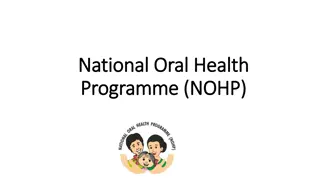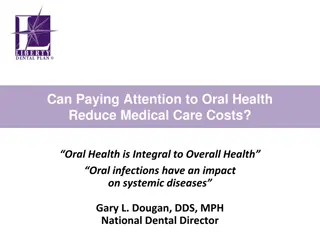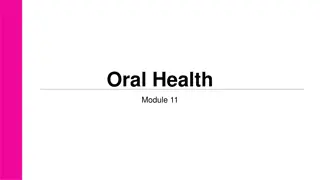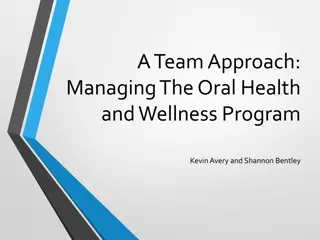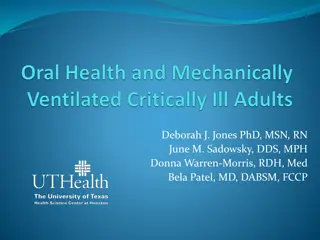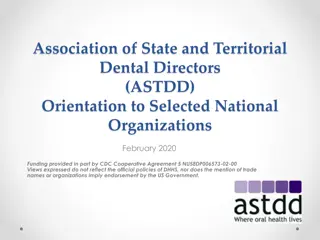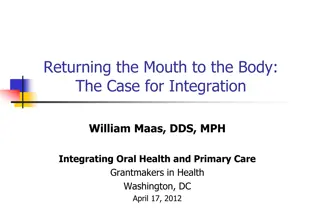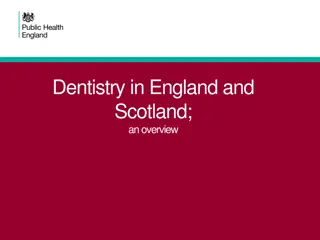Dental Dietary Counseling: Enhancing Oral Health Through Nutrition
Providing dietary counseling plays a crucial role in promoting oral health by educating patients on the impact of food choices on dental well-being. This involves identifying high-risk individuals, evaluating their diet, and creating personalized action plans to improve their dietary habits. Through initiatives like recording food consumption, emphasizing breastfeeding for infants, and educating on the risks of excessive carbohydrate intake, dental professionals can help patients achieve better oral health outcomes.
Download Presentation

Please find below an Image/Link to download the presentation.
The content on the website is provided AS IS for your information and personal use only. It may not be sold, licensed, or shared on other websites without obtaining consent from the author.If you encounter any issues during the download, it is possible that the publisher has removed the file from their server.
You are allowed to download the files provided on this website for personal or commercial use, subject to the condition that they are used lawfully. All files are the property of their respective owners.
The content on the website is provided AS IS for your information and personal use only. It may not be sold, licensed, or shared on other websites without obtaining consent from the author.
E N D
Presentation Transcript
L O V E L Y BUT, through these you send me my enemies . You like to have!!!!!! Ha!ha!ha! Ha!ha!ha! T H I N G S THE GERMS These germs destroy me!!! Ah!! Help me & Please help me!!
IT IS THE ACT OF PROVIDING ADVISE AND GUIDANCE TO A PATIENT OR THE PATIENTS FAMILY REGARDING THE TYPE OF FOOD THAT SHOULD BE TAKEN AND ITS RELATION TO BOTH HEALTH AND DISEASE
To modify dietary habits, particularly ingestion of sucrose containing amounts that promote caries To correct dietary interfere with the patient s general health and well being foods, in forms and imbalances that could
Breast feeding of infants to ensure best possible health , psychosocial outcomes developmental and Educating people about association between frequent consumption of carbohydrates and caries Educating people about other health risks associated with excess carbohydrates , fats and sodium consumption of
1) First appointment - Identification of high-risk patients. - Maintaining the diet diary 2) Second appointment - Evaluation of the diet diary - Develop an action plan - Well balanced diet - Use of Nutritive sugar substitutes 3) Third appointment - Evaluation of the progress
Record every food item consumed solid or liquid during 6 consecutive days Record food consumed during mealtimes, between meals. Use appropriate household measure the amount of food. The kind of food and how it was prepared. Addition to the food in cooking or at table measures to
Patient should have a positive attitude and be willing and to make long- term efforts towards improvement of oral status through dietary means. Should have a demonstrable need for dietary improvement.
Personal data Likes and dislikes GATHERING INFORMATION Cause of problem Suggest diet diary
EVALUATE AND INTERPRET INFORMATION Nutritional adequacy of diet Amount of sugary foods Frequency of sugary foods Personal and social history Medical history Systemic and environmental factors
Gradual, qualitative changes in diet Gradually eliminate sugary foods Avoid patient dislikes Prescribed diet should vary from normal diet pattern as little as possible Nutritionally balanced diet Increase intake of protective and detergent foods fruits, vegetables, cheese, etc
Patient encouraged to involve himself in diet monitoring and suggest changes in menu REGULAR FOLLOW UP To Make changes monitor progress To motivate and encourage To clarify doubts
Caries susceptibility refers to the number of new lesions that may develop in an individual over a period of time Caries susceptibility Varies: -in different individuals, -in an individual in different teeth -also on the different surfaces of each tooth
Sex Higher caries experience in permanent Teeth of females as compared to males of the same chorological age Age New carious lesion per years has 3 peaks at ages 4-8 ,11-19 & between 55 and 65 yrs
Race Race also effects as it implies cultural social economic and possibly genetic differences and therefore differences in the diet ,oral hygiene and education African & Asian people have low caries scores as compared to the industrialized countries of Europe and North America
Familial Factors Children of parents with low caries have a low caries experience. Siblings of individuals that are caries free exhibit a low caries rate [Gaemetal, 1976] Time factors for caries development after eruption After a tooth erupts there is a rapid rise and then an equally sharp decrease in caries susceptibility
The increment of active lesions, including new and recurrent lesions that occur over a stated period of time
To determine the need and extent of personalized preventive measures. To serve as an index of the success of the therapeutic measures. To motivate and to monitor the effectiveness of education programs relating to dietary and oral hygiene procedures. To manage the progress of restorative procedures. To identify high risk groups and individuals.
1) Lactobacillus colony count test 2) Calorimetric snyder test 3) Swab test 4) Streptoccocus mutans levels in saliva 5) Salivary buffer capacity 6) Enamel solubility test 7) Saliva reductase test 8) Albans test 9) Fosdick calcium dissolution test 10) Dewar test 11) Cariostat test
Introduced by HADLEY in 1933 and popularized by JAY. METHOD: Immediately after arising the patient chews a small piece of paraffin. The saliva that accumulates in the following 3 minute period is collected in a sterile container.
LACTOBACILLUS COLONY COUNT TEST Saliva collected is shaken by a machine for 2 minutes. The saliva sample is diluted with distilled water and duplicate 1 ml and 0.1ml aliquots Diluted sample are spread evenly on petridishes containing 20ml of cooled liquefied agar (Rogasa s SL agar plate). The plates are incubated for 3 to 4 days at 37 C The number of Lactobacillus colonies that develop are counted.
LACTOBACILLUS COLONY COUNT TEST No. Of organisms per ml saliva Symbolic designation Degree of caries activity suggested 0 - 1000 Little or none 1000 - 5000 + slight 5000 10,000 + + moderate More than 10,000 + + + OR + + + + marked
It measures the ability of salivary micro-organisms to form organic acids from a carbohydrate medium. The medium contains an indicator dye, Bromocresol green. This dye changes colour from green to yellow in the range of pH 5.4 to 3.8. Salivary sample is collected in the same manner used in the Lactobacillus test.
CALORIMETRIC SNYDER TEST Immediately after arising the patient chews a small piece of paraffin. The saliva that accumulates in the following 3 minute period is collected in a sterile container. Saliva collected is shaken by a machine for 2 minutes
CALORIMETRIC SNYDER TEST After the salivary sample is thoroughly mixed, 0.2 cc of saliva is pipetted into the melted medium at 50 C. The inoculation period is upto 72 hours. The rate of colour change from green to yellow is indicative of the degree of caries activity.
CALORIMETRIC SNYDER TEST Time, Hours 24 48 72 Colour Yellow Yellow Yellow Caries activity Marked Definite Limited Colour Green Green Green Caries activity Continue test Continue test Inactive
Developed by GRAINGER et al in 1965. Advantage- no collection of saliva is necessary. So it is valuable in evaluation caries activity in very young children. Principle: ( same as Snyder's test ) The oral flora is sampled by swabbing the buccal surfaces of the teeth with a cotton applicator, which is subsequently incubated in the medium. The change in the pH following a 48 hour incubation is read on a pH meter or the colour change is read by the use of a colour comparator.
THE SWAB TEST Interpretation : pH 4.1 and < 4.1 pH 4.2 to 4.4 pH 4.5 to 4.6 pH 4.6 and over = Marked caries activity = Active = Slightly active = Caries active
Measures the number of Streptococcus mutans colony forming units per unit volume of saliva. Procedure: The samples of organisms is obtained by the use of tongue blades (wooden spatulas) Sample then pressed against Streptococcus Mutans selective MSB (Mitus Salivarius Bacitracin) Agar in special Petri dishes.
STREPTOCOCCUS MUTANS LEVELS IN SALIVA Interpretation : Levels of Streptococcus Mutans > 10 5/ ml of saliva = unacceptable, Colonization of a new surface does not occur readily unless the level of S. mutans in saliva reaches a critical value of about 4.5 x 104 Per ml for smooth surface and about 103 for occlusal fissures
Collection and titration of saliva in this test must be carried out under a layer of paraffin oil to prevent loss of bicarbonate anion. 2 ml of saliva collected under paraffin oil are + 4 ml of distilled water (under a paraffin seal. ) The delivery end of a microburet and a microglass electrode are introduced under the seal and the amount of 0.5 N HCL, required to bring the saliva to pH 5.0 is measured.
SALIVARY BUFFER CAPACITY Saliva samples requiring less than 0.45 ml of standard HCI in this test have low buffer capacity Those requiring 0.45 ml or more have high buffer capacity.
Based on the fact that when glucose is added to the saliva containing powdered enamel, organic acids are formed. These inturn decalcify the enamel, resulting in an increase in the amount of soluble calcium in the Saliva Glucose Enamel mixture. The extent of increased calcium is a direct measure of the degree of caries susceptibility.
This test measures the activity of the reductase enzyme present in salivary bacteria. Kit used is -Treatex. Saliva collected in a plastic container. The sample is then mixed with the dye Diazoresorcinal, The colour changes and the CariesConduciveness reading is taken after 15 minutes
COLOUR CARIES CONDUCIVENESS Non Conducive Blue in 15 minutes Orchid in 15 minutes Slightly Conducive Red in 15 minutes Moderately Conducive Red Immediately on Mixing Highly Conducive Colourless in 15 minutes Extremely Conducive
Main Features: Use of a somewhat softer medium that permits the diffusion of saliva and acids without the necessity of melting the medium. Use of simpler sampling procedure in which the patient expectorates directly into tubes that contain the medium.
ALBAN TEST The tubes are observed daily for: Change of colour from bluish green (pH 5) to definite yellow (pH 4 or below). The depth in the medium to which the change has occurred. The daily results collected for a 4 day period should be recorded on the patients chart.
ALBAN TEST Scale for Scoring: 1. No colour change 2. Beginning colour change (from to of medium down) 3. One hald colour change (from top down) 4. Three fourths colour change (from top down) 5. Total colour changes to yellow = 3/4 = + = ++ = +++ = ++++
ALBAN TEST The following method is used for final recordings, after 72 or 96 hours of incubation Readings negative for the entire incubation period are labeled negative All other readings are labeled positive whether +, ++, +++, or ++++.
ALBAN TEST Slower change or less colour change (compared to previous test) is labeled improved Faster change or more pronounced colour change (compared to previous test) is labeled worse . When consecutive readings are nearly identical, they are labeled no change .
Measures the amount of powdered enamel dissolved in 4 hours, when mixed with glucose and the patients saliva. Disadvantage: Correlation between the amount of enamel dissolved and the caries susceptibility of the patient has not been found to be accurate
Test similar to fosdick calcium dissolution test Except that in this test the pH of the mixture is measured instead of the amount of calcium dissolved by the acid.
C.R.T. (caries risk test) -new, quick and effective caries activity test Enables some acid producing bacteria and acid tolerating bacteria to survive in its medium so that the ability of acid production by these bacteria can be measured Cariostat is superior to radiographic examination for detection of initial proximal caries
CARIOSTAT TEST C.R.T. has 2 components: 1. C.R.T. bacteria- which allows a number of cariogenic bacteria in the patients saliva 2. C.R.T. buffer- which determines the buffering capacity of the patients saliva C.R.T. bacteria is a two-in one dip in slide test which identifies counts of a) mutans streptococci b) lactobacilli
CARIOSTAT TEST METHOD: Stimulated saliva is collected Applied to both the slides of the dip-in-slide This is then incubated for 48hours at 37 C The C.R.T. buffer is available in strip form, which changes colour to indicate whether the patient has high, medium or low buffering capacity. This occurs in 5 minutes.
None of the tests are highly reliable as indicators of expected caries increment Caries activity tests measure a single parameter such as acid produced or colony count of a bacterial species However caries is a multifactorial disease and caries predictive tests do not encompass those factors involved in determining caries resistance such as fluoride exposure, maturation of enamel, or immune protection.








